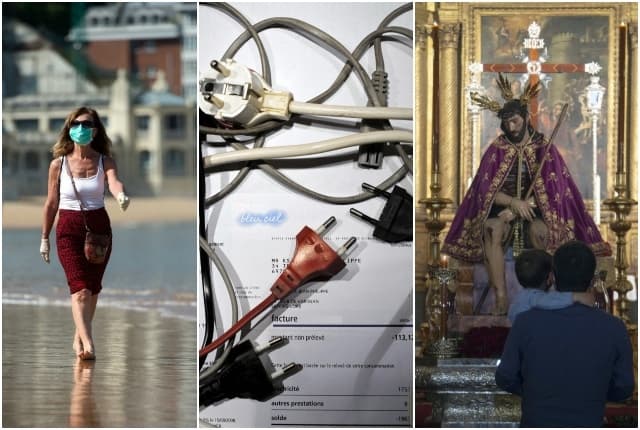What changes about life in Spain in April 2021

The month of April 2021 in Spain brings with it changes to Covid measures, high expectations for the vaccine campaign, tax deadlines and different rates for electricity bills, among other changes. Here's what you need to know.
Facemasks on in ALL public places
The Spanish government on Tuesday March 30th passed a decree which will require people to wear face masks outdoors in all public settings, including beaches, swimming pools and in nature where in some regions it was previously not necessary.
So April will be the first full month where all of Spain’s 47 million inhabitants, and the tourists that visit the country, have to keep on their mask technically even while sunbathing alone on a deserted beach or trekking through a quiet forest.
Needless to say it’s a controversial move by Spanish authorities which you can learn more about here.
High expectations for Spain’s vaccine rollout
Spain’s Health Ministry is eyeing April as the month when the country’s vaccine strategy will and has to take off, especially if it wants to boost its ailing economy and save its tourism industry.
Spanish authorities will receive more than five million Pfizer and Moderna vaccine doses over the course of April, added to the one million extra doses of the German and American inoculations it was sent on Monday March 29th.
Following the temporary suspension of the AstraZeneca vaccine for a week in March over fears they were linked to blood clot incidences (so far been ruled out by the European Medicine Agency), Spain’s Health Ministry on Tuesday 30th decided to start offering this inoculation to people over the age of 65.
April will also see the first Janssen vaccines arrive in Spain - 1.3 million doses - which are expected to be administered to people aged 66 and over from mid-April.
Spain has upped its daily vaccine rollout to an average of 200,000 administered doses per day, but the inoculation machine will have to be even more effective if the country wants to achieve its immunisation targets by the summer.
So far, 7.7 million Covid vaccine doses have been administered in Spain since the campaign began in late December. Five million people - 10.8 percent of the population - have received at least one dose. Only 5.8 percent of Spain’s 47 million inhabitants have received the full vaccination.
Lots of important tax stuff, especially for self-employed
April 7th marks the start of Spain’s 2020-2021 income tax campaign, when online presentations open.
You can find out more about the important tax dates to watch out for this year here and what changes have been introduced as a result of the coronavirus crisis here.
Self-employed people in Spain have until April 20th to submit their income tax withholding declaration and VAT self-assessment (la declaración de retenciones de IRPF y la autoliquidación del IVA). Photo: Lukas Bieri/Pixabay
Photo: Lukas Bieri/Pixabay
Usually these are forms 111 (declaración trimestral retenciones de personal y profesionales) and 115 (declaración trimestral retenciones de alquileres).
Autónomos may also have to submit modelo 303 for their quarterly VAT assessment, modelo 349 for the tax return of intra-community transactions, modelo 130 if they are taxed on direct estimation or modelo 131 if they are taxed on objective estimation or modules.The deadline for these is also April 20th.
If all this seems like too much to handle, it may be time you enlist the help of a Spanish gestor to help you navigate Spain’s complex bureaucracy.
A quiet Easter, but will it be a quiet month too?
If you’re based in Spain you probably know this already, but as a reminder, crossing regional borders to go on Easter holidays in another part of Spain is not allowed if you’re a local or foreign resident in Spain.
The major processions that usually dominate Holy Week in Spain, especially in Andalusia, have all been cancelled, although masses will be held and some smaller processions (pasos) will be allowed to take place but with a limited public.
Semana Santa officially ends on Sunday April 4th but depending on the epidemiological situation across Spain’s 17 autonomous communities, it could be that some regional borders are kept closed for longer during the month of April.
The Valencia region for example doesn’t intend to lift its regional border closure until May 9th, so there can be no going out of the region until then unless you can justify one of accepted exceptions.
It’s fair to say that inter-regional travel is likely to be generally put on ice for the near future in Spain, especially as the country’s fortnightly infection rate has been crawling up in the past week from 128 cases per 100,000 people to currently around 149 cases per 100,000.
Tourism authorities will want to make sure they can ‘save the summer’, by preventing or mitigating the effects of a fourth wave ahead of the financially crucial summer tourism period.
It’s spring fruit and veg time in Spain
There may not be a lot to look forward to with life’s current uncertainty, but eating healthily and well is always a plus of life in Spain.
With the arrival of spring comes also the harvest of typical primavera (spring) fruits and vegetables in Spain, with abundance likely to drive down prices.
April is a good month to buy cherries, oranges, avocados as well as chard, artichokes, celery, asparagus, peas and endives.
 Photo: Couleur/Pixabay
Photo: Couleur/Pixabay
Travel to Spain from outside EU not possible in April
On Monday March 29th, Spain extended its restrictions on non-essential journeys from countries outside the EU and Schengen Area until April 30th.
That means travellers from countries outside of the Schengen Area will not be able to make non-essential journeys to Spain by land, air or sea over the Easter period and throughout the month of April.
However, travellers from some countries with low infection rates will be able to make the journey, including those from Australia, New Zealand, Rwanda, Singapore, South Korea, Thailand, China (subject to reciprocity) and the regions of Hong Kong and Macao, as there are Schengen-wide agreements allowing for this.
It’s worth noting that the extensions of restrictions do not apply to Gibraltar, given the fact that they have vaccinated almost all their population against Covid-19. Restrictions on non-essential travel from Gibraltar to Spain will be lifted at 6pm on March 30th.
Changes to Spanish electricity bills
On April 1st, the Spanish government will introduce changes to how electricity bills are calculated, namely its discrimación horaria, Spain’s electrical hourly discrimation rule.
Knowing what time electricity is cheapest can save users up to €70 euros a year, according to Spanish consumer group OCU.
The main change is that there will be three time slots with different rates each:
- Peaktime (the most expensive) : in the morning between 10:00 a.m. and 2:00 p.m. and in the afternoon / evening between 6:00 p.m. and 10:00 p.m.
- Flat rate(somewhat cheaper) : in the morning, from 8:00 a.m. to 10:00 a.m., in the afternoon from 2:00 p.m. to 6:00 p.m., and at night from 10:00 p.m. to 12:00 p.m.
- Off-peak rate (the cheapest) : from 0:00 am to 8:00 am.
If you are in the PVPC regulated price mode, the new periods of time discrimination will automatically be applied to your contracted rate.
The PVPC is the Voluntary Small Consumer Price, the system that the Spanish government has to establish an hourly rate for electricity.
EXPLAINED: How to apply for a discount on your Spanish electricity bill
The rain in Spain
The first half of April will be somewhat rainier than normal for the time of year and temperatures will be the usual in the mainland and the Canary Islands, while in the Balearic Islands weather site Eltiempo.es is forecasting warmer weather than normal for this month.
April is usually a very rainy month in the north of Spain , especially in Galicia, the Cantabrian Sea, Navarra and the north of Huesca. No wonder the Spanish saying goes ‘en abril, agua es mil’ (in April water is a thousand).
By contrast, the driest areas are usually Murcia, Almería and the Canary Islands.
Gran intrusión de polvo en suspensión prevista por @Dust_Barcelona para acabar marzo y comenzar abril. pic.twitter.com/yX7hub74Zo
— AEMET_C. Valenciana (@AEMET_CValencia) March 30, 2021
Eltiempo.es is also predicting there will be a lot of dust in suspension over large swathes of Spain and the Canaries in Easter, known as calima, a nuisance for people with breathing difficulties and allergies.
Comments
See Also
Facemasks on in ALL public places
The Spanish government on Tuesday March 30th passed a decree which will require people to wear face masks outdoors in all public settings, including beaches, swimming pools and in nature where in some regions it was previously not necessary.
So April will be the first full month where all of Spain’s 47 million inhabitants, and the tourists that visit the country, have to keep on their mask technically even while sunbathing alone on a deserted beach or trekking through a quiet forest.
Needless to say it’s a controversial move by Spanish authorities which you can learn more about here.
High expectations for Spain’s vaccine rollout
Spain’s Health Ministry is eyeing April as the month when the country’s vaccine strategy will and has to take off, especially if it wants to boost its ailing economy and save its tourism industry.
Spanish authorities will receive more than five million Pfizer and Moderna vaccine doses over the course of April, added to the one million extra doses of the German and American inoculations it was sent on Monday March 29th.
Following the temporary suspension of the AstraZeneca vaccine for a week in March over fears they were linked to blood clot incidences (so far been ruled out by the European Medicine Agency), Spain’s Health Ministry on Tuesday 30th decided to start offering this inoculation to people over the age of 65.
April will also see the first Janssen vaccines arrive in Spain - 1.3 million doses - which are expected to be administered to people aged 66 and over from mid-April.
Spain has upped its daily vaccine rollout to an average of 200,000 administered doses per day, but the inoculation machine will have to be even more effective if the country wants to achieve its immunisation targets by the summer.
So far, 7.7 million Covid vaccine doses have been administered in Spain since the campaign began in late December. Five million people - 10.8 percent of the population - have received at least one dose. Only 5.8 percent of Spain’s 47 million inhabitants have received the full vaccination.
Lots of important tax stuff, especially for self-employed
April 7th marks the start of Spain’s 2020-2021 income tax campaign, when online presentations open.
You can find out more about the important tax dates to watch out for this year here and what changes have been introduced as a result of the coronavirus crisis here.
Self-employed people in Spain have until April 20th to submit their income tax withholding declaration and VAT self-assessment (la declaración de retenciones de IRPF y la autoliquidación del IVA). Photo: Lukas Bieri/Pixabay
Photo: Lukas Bieri/Pixabay
Usually these are forms 111 (declaración trimestral retenciones de personal y profesionales) and 115 (declaración trimestral retenciones de alquileres).
Autónomos may also have to submit modelo 303 for their quarterly VAT assessment, modelo 349 for the tax return of intra-community transactions, modelo 130 if they are taxed on direct estimation or modelo 131 if they are taxed on objective estimation or modules.The deadline for these is also April 20th.
If all this seems like too much to handle, it may be time you enlist the help of a Spanish gestor to help you navigate Spain’s complex bureaucracy.
A quiet Easter, but will it be a quiet month too?
If you’re based in Spain you probably know this already, but as a reminder, crossing regional borders to go on Easter holidays in another part of Spain is not allowed if you’re a local or foreign resident in Spain.
The major processions that usually dominate Holy Week in Spain, especially in Andalusia, have all been cancelled, although masses will be held and some smaller processions (pasos) will be allowed to take place but with a limited public.
Semana Santa officially ends on Sunday April 4th but depending on the epidemiological situation across Spain’s 17 autonomous communities, it could be that some regional borders are kept closed for longer during the month of April.
The Valencia region for example doesn’t intend to lift its regional border closure until May 9th, so there can be no going out of the region until then unless you can justify one of accepted exceptions.
It’s fair to say that inter-regional travel is likely to be generally put on ice for the near future in Spain, especially as the country’s fortnightly infection rate has been crawling up in the past week from 128 cases per 100,000 people to currently around 149 cases per 100,000.
Tourism authorities will want to make sure they can ‘save the summer’, by preventing or mitigating the effects of a fourth wave ahead of the financially crucial summer tourism period.
It’s spring fruit and veg time in Spain
There may not be a lot to look forward to with life’s current uncertainty, but eating healthily and well is always a plus of life in Spain.
With the arrival of spring comes also the harvest of typical primavera (spring) fruits and vegetables in Spain, with abundance likely to drive down prices.
April is a good month to buy cherries, oranges, avocados as well as chard, artichokes, celery, asparagus, peas and endives.
 Photo: Couleur/Pixabay
Photo: Couleur/Pixabay
Travel to Spain from outside EU not possible in April
On Monday March 29th, Spain extended its restrictions on non-essential journeys from countries outside the EU and Schengen Area until April 30th.
That means travellers from countries outside of the Schengen Area will not be able to make non-essential journeys to Spain by land, air or sea over the Easter period and throughout the month of April.
However, travellers from some countries with low infection rates will be able to make the journey, including those from Australia, New Zealand, Rwanda, Singapore, South Korea, Thailand, China (subject to reciprocity) and the regions of Hong Kong and Macao, as there are Schengen-wide agreements allowing for this.
It’s worth noting that the extensions of restrictions do not apply to Gibraltar, given the fact that they have vaccinated almost all their population against Covid-19. Restrictions on non-essential travel from Gibraltar to Spain will be lifted at 6pm on March 30th.
Changes to Spanish electricity bills
On April 1st, the Spanish government will introduce changes to how electricity bills are calculated, namely its discrimación horaria, Spain’s electrical hourly discrimation rule.
Knowing what time electricity is cheapest can save users up to €70 euros a year, according to Spanish consumer group OCU.
The main change is that there will be three time slots with different rates each:
- Peaktime (the most expensive) : in the morning between 10:00 a.m. and 2:00 p.m. and in the afternoon / evening between 6:00 p.m. and 10:00 p.m.
- Flat rate(somewhat cheaper) : in the morning, from 8:00 a.m. to 10:00 a.m., in the afternoon from 2:00 p.m. to 6:00 p.m., and at night from 10:00 p.m. to 12:00 p.m.
- Off-peak rate (the cheapest) : from 0:00 am to 8:00 am.
If you are in the PVPC regulated price mode, the new periods of time discrimination will automatically be applied to your contracted rate.
The PVPC is the Voluntary Small Consumer Price, the system that the Spanish government has to establish an hourly rate for electricity.
EXPLAINED: How to apply for a discount on your Spanish electricity bill
The rain in Spain
The first half of April will be somewhat rainier than normal for the time of year and temperatures will be the usual in the mainland and the Canary Islands, while in the Balearic Islands weather site Eltiempo.es is forecasting warmer weather than normal for this month.
April is usually a very rainy month in the north of Spain , especially in Galicia, the Cantabrian Sea, Navarra and the north of Huesca. No wonder the Spanish saying goes ‘en abril, agua es mil’ (in April water is a thousand).
By contrast, the driest areas are usually Murcia, Almería and the Canary Islands.
Gran intrusión de polvo en suspensión prevista por @Dust_Barcelona para acabar marzo y comenzar abril. pic.twitter.com/yX7hub74Zo
— AEMET_C. Valenciana (@AEMET_CValencia) March 30, 2021
Eltiempo.es is also predicting there will be a lot of dust in suspension over large swathes of Spain and the Canaries in Easter, known as calima, a nuisance for people with breathing difficulties and allergies.
Join the conversation in our comments section below. Share your own views and experience and if you have a question or suggestion for our journalists then email us at [email protected].
Please keep comments civil, constructive and on topic – and make sure to read our terms of use before getting involved.
Please log in here to leave a comment.